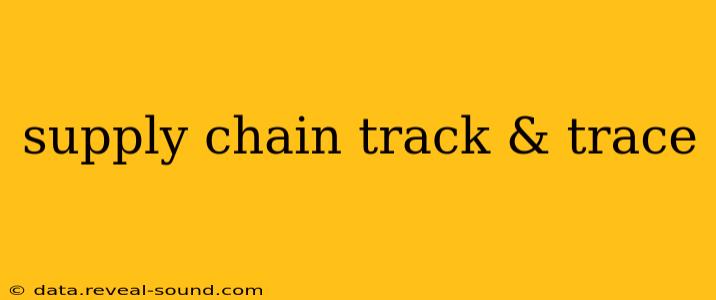The modern supply chain is a complex web of interconnected processes, spanning geographical boundaries and involving numerous stakeholders. Maintaining visibility and control throughout this intricate network is paramount for businesses striving for efficiency, agility, and customer satisfaction. This is where supply chain track and trace solutions come into play. They provide the crucial ability to monitor goods in real-time, from origin to final delivery, offering unparalleled insights into every stage of the journey. This detailed overview delves into the benefits, technologies, and challenges associated with implementing effective track and trace systems.
What is Supply Chain Track and Trace?
Supply chain track and trace refers to the process of monitoring and recording the movement of goods throughout the entire supply chain. This involves using various technologies to collect data on the location, status, and condition of products at each stage, from raw material sourcing to delivery to the end customer. By providing real-time visibility, track and trace helps businesses optimize operations, reduce costs, and improve customer experiences. It moves beyond simply knowing where a shipment is; it provides context, allowing for proactive issue resolution and informed decision-making.
How Does Supply Chain Track and Trace Work?
Several technologies underpin modern track and trace systems. These include:
-
RFID (Radio-Frequency Identification): RFID tags attached to products or pallets emit unique signals that can be read by scanners, providing real-time location data. This technology is particularly useful for high-volume or fast-moving goods.
-
GPS (Global Positioning System): GPS trackers placed on shipping containers or vehicles offer precise location information, ideal for tracking shipments in transit.
-
Barcode and QR Code Scanning: While less sophisticated than RFID or GPS, barcodes and QR codes still play a significant role in track and trace, providing basic identification and tracking capabilities.
-
IoT (Internet of Things) Sensors: These sensors can monitor various parameters such as temperature, humidity, and shock, providing valuable insights into the condition of goods during transit. This is crucial for temperature-sensitive products like pharmaceuticals or perishable goods.
-
Blockchain Technology: Blockchain offers a secure and transparent platform for recording and sharing supply chain data, enhancing traceability and preventing fraud.
What are the Benefits of Supply Chain Track and Trace?
Implementing a robust track and trace system offers a multitude of benefits:
-
Improved Visibility: Real-time tracking provides a clear picture of inventory location and movement, eliminating guesswork and enhancing decision-making.
-
Enhanced Efficiency: Identifying bottlenecks and inefficiencies early allows for proactive intervention and optimized processes.
-
Reduced Costs: Minimized losses due to theft, damage, or delays can significantly reduce overall costs.
-
Improved Customer Service: Providing customers with accurate delivery updates and proactive communication enhances satisfaction and builds trust.
-
Better Inventory Management: Accurate inventory tracking minimizes stockouts and overstocking, improving resource allocation.
-
Increased Compliance: Track and trace systems help ensure compliance with industry regulations and standards, reducing the risk of penalties.
-
Enhanced Security: Real-time monitoring helps prevent theft and counterfeiting, safeguarding valuable goods.
What are the Challenges of Implementing Supply Chain Track and Trace?
Despite the numerous advantages, implementing a successful track and trace system can present challenges:
-
Integration Complexity: Integrating various technologies and systems across the entire supply chain can be complex and require significant IT investment.
-
Data Management: Managing large volumes of data generated by track and trace systems requires robust infrastructure and analytical capabilities.
-
Cost of Implementation: The initial investment in hardware, software, and integration can be substantial.
-
Data Security: Protecting sensitive supply chain data from unauthorized access is crucial and requires robust security measures.
What Technologies are Used for Supply Chain Track & Trace?
(This question is already addressed in the "How Does Supply Chain Track and Trace Work?" section above.)
How Much Does Supply Chain Track & Trace Cost?
The cost of implementing a supply chain track and trace system varies significantly depending on factors such as the size and complexity of the supply chain, the technologies used, and the level of integration required. Smaller businesses may be able to implement basic systems at a relatively low cost, while larger enterprises with complex global supply chains may require more substantial investments. Consultations with technology providers are essential to obtain accurate cost estimates based on specific needs.
What are the Key Performance Indicators (KPIs) for Supply Chain Track & Trace?
Effective measurement of track and trace success necessitates the use of key performance indicators (KPIs). These can include:
-
On-time delivery rate: The percentage of shipments delivered on or before the scheduled date.
-
Order fulfillment cycle time: The time taken to process an order from placement to delivery.
-
Inventory accuracy: The degree of accuracy in inventory records.
-
Shipment visibility: The percentage of shipments with real-time location tracking.
-
Return on investment (ROI): The return on the investment in the track and trace system, considering cost savings and efficiency gains.
Conclusion
Supply chain track and trace is no longer a luxury but a necessity for businesses operating in today's competitive environment. By providing real-time visibility and control over the movement of goods, these systems offer significant advantages in terms of efficiency, cost reduction, and customer satisfaction. While challenges exist in implementation, the benefits far outweigh the costs for businesses seeking to optimize their supply chains and achieve sustainable growth.
